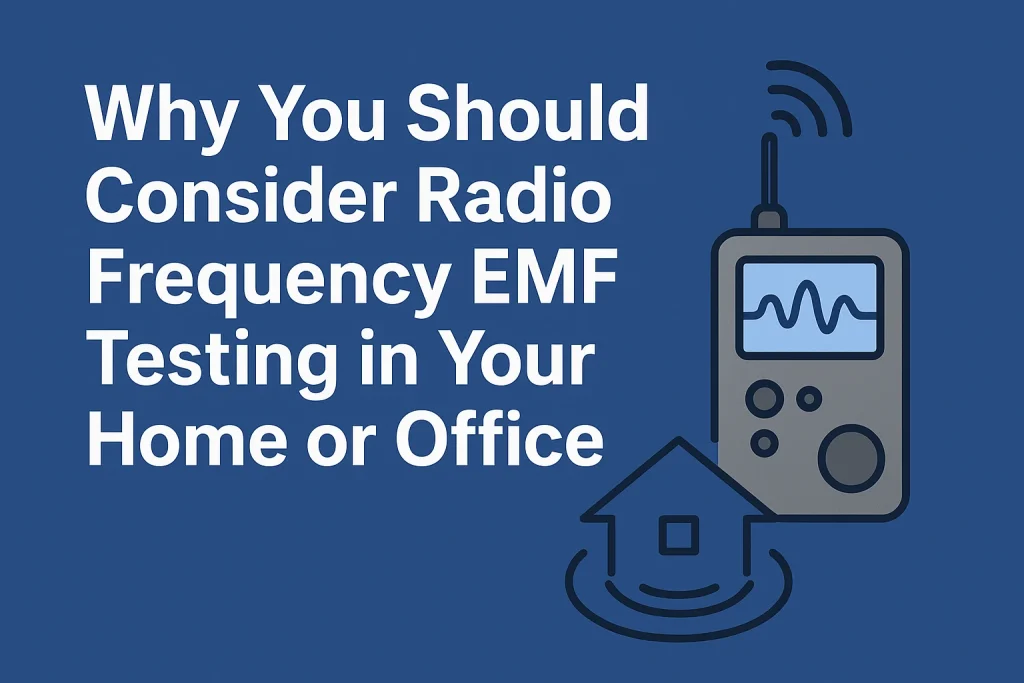In our increasingly connected world, invisible forces like Wi-Fi, Bluetooth, and cellular signals make modern life more convenient. Yet behind that convenience lies an often-overlooked concern: radio frequency electromagnetic fields (RF EMFs). As the use of wireless devices continues to rise, so does our exposure to these frequencies. This is where radio frequency EMF testing becomes an essential step toward creating a safer and healthier environment—both at home and in the workplace.
Below, we’ll explore what RF EMFs are, why testing matters, the benefits of testing in different environments, and practical steps you can take to minimize exposure.
Understanding Radio Frequency EMFs
Radio frequency electromagnetic fields (RF EMFs) are a type of non-ionizing radiation that comes from wireless technologies such as:
- Wi-Fi routers
- Mobile phones and cell towers
- Bluetooth devices
- Smart meters
- Microwave ovens
- Wireless baby monitors
- Smart home devices
These devices emit electromagnetic radiation in varying intensities. While RF EMFs do not have enough energy to ionize atoms (unlike X-rays or gamma rays), long-term exposure to high levels has raised concerns among health professionals and researchers.
Numerous studies have investigated whether constant low-level RF exposure might have biological effects, ranging from sleep disruption and headaches to potential long-term risks. While conclusive evidence remains under debate, the precautionary principle—minimizing exposure where possible—has become a reasonable approach.
What Is Radio Frequency EMF Testing?
Radio frequency EMF testing is the process of measuring and assessing the levels of electromagnetic radiation present in a specific environment, such as your home or office. It is usually conducted by professionals using specialized instruments that can detect the strength, frequency, and sources of EMF radiation.
During testing, experts typically:
- Identify major sources of RF radiation (Wi-Fi routers, cell towers, smart devices, etc.)
- Measure radiation intensity in different areas and at various times of the day
- Compare results to safety standards and guidelines set by organizations such as the International Commission on Non-Ionizing Radiation Protection (ICNIRP) or the Federal Communications Commission (FCC)
- Recommend mitigation strategies to lower exposure
The data collected gives you an accurate picture of your EMF environment, helping you make informed decisions about how to protect your health and well-being.
Why Testing Matters: The Hidden Nature of EMFs
The challenge with RF radiation is that you can’t see, smell, or feel it. Without proper equipment, it’s impossible to know how much exposure you’re experiencing in your daily environment.
For instance:
- That Wi-Fi router tucked under your desk could be emitting stronger signals than necessary.
- Your bedroom might be affected by your neighbor’s smart meter or Wi-Fi network.
- Office environments filled with laptops, wireless printers, and cell phones could be creating a high cumulative exposure zone.
Testing removes the guesswork. It gives you measurable data, allowing you to pinpoint problem areas and make targeted improvements rather than taking random or unnecessary measures.
Health and Productivity Implications of RF Exposure
1. Impact on Sleep and Concentration
Prolonged exposure to high RF levels has been linked in some studies to disturbances in sleep patterns. Because RF radiation may affect melatonin synthesis and circadian rhythm, it may make it difficult to fall or remain asleep. In an office environment, excessive EMF exposure might contribute to fatigue, difficulty concentrating, or feelings of brain fog.
2. Potential Biological Effects
While scientific consensus has not definitively proven that RF exposure causes serious health problems, some research has indicated possible biological effects, including changes in cell activity, oxidative stress, and thermal effects on tissues. Testing provides the first step in understanding your exposure level so that precautionary measures can be implemented responsibly.
3. Reduced Productivity and Well-Being in the Workplace
In office settings, EMF exposure combined with artificial lighting and limited ventilation can contribute to what’s often called “electronic stress.” Employees may experience more headaches, eye strain, or fatigue. By testing and managing RF levels, employers can create a more balanced work environment, potentially improving morale and productivity.
The Benefits of Radio Frequency EMF Testing at Home
Your home should be a sanctuary, a place where your body can recover from the stresses of daily life. However, many modern homes are filled with wireless devices constantly emitting radiation. Conducting RF EMF testing can bring several benefits:
1. Peace of Mind
Knowing the exact levels of electromagnetic radiation in your home removes fear and uncertainty. If levels are low, you’ll have reassurance. If they’re high, you can take meaningful steps to reduce them.
2. Better Sleep Quality
Testing may reveal that your bedroom has higher-than-expected RF levels, often from Wi-Fi routers, cordless phones, or nearby cell towers. Simple adjustments—like relocating devices or using shielding materials—can help restore more natural sleep patterns.
3. Improved Family Health
Children are particularly sensitive to environmental factors, and some experts recommend minimizing unnecessary RF exposure for them. Testing helps identify hidden sources of radiation, such as wireless baby monitors or smart toys, so you can make informed choices for your family’s safety.
4. Enhanced Energy Efficiency
During testing, professionals often identify electronic devices that emit unnecessary radiation because they’re constantly transmitting. By turning off or reconfiguring these devices, you can also save energy and reduce your electricity bill.
The Benefits of Radio Frequency EMF Testing in the Workplace
While homes are important, offices and workspaces deserve equal attention. Employees often spend eight or more hours daily surrounded by wireless equipment. Testing can benefit workplaces in several ways:
1. Ensuring Compliance and Safety
Organizations must adhere to workplace safety standards, including limits on electromagnetic exposure. Testing ensures your environment complies with recommended guidelines, reducing liability and ensuring regulatory compliance.
2. Boosting Employee Health and Focus
A low-EMF environment can contribute to fewer headaches, improved focus, and less fatigue—factors that directly influence employee performance. When workers feel physically and mentally balanced, productivity naturally increases.
3. Promoting a Health-Conscious Image
Businesses that invest in health and safety initiatives demonstrate corporate responsibility. Offering an RF-tested workspace shows employees and clients alike that you care about their well-being, fostering trust and a positive reputation.
4. Identifying Technical Issues
Sometimes, excessive RF levels can indicate malfunctioning devices or improperly shielded equipment. Testing helps detect these problems early, preventing potential equipment failures and data interference.
What Happens During an RF EMF Test?
If you decide to book a professional test, here’s what to expect:
- Initial Consultation: The testing expert will discuss your environment, concerns, and potential RF sources.
- Site Assessment: Using specialized meters, they’ll take readings across different areas—walls, workstations, sleeping areas, and near electronic devices.
- Data Analysis: Measurements are analyzed and compared with international safety guidelines to assess risk levels.
- Comprehensive Report: You’ll receive a detailed report explaining the findings, including graphs, heat maps, and recommendations for mitigation.
- Practical Recommendations: These may include relocating routers, using wired connections, shielding windows or walls, and adjusting device placement.
How to Choose a Qualified EMF Testing Professional?
Not all testing services are created equal. To ensure accuracy and reliability:
- Verify certifications: Professionals should utilize calibrated, industry-standard instruments and adhere to guidelines established by ICNIRP or IEEE.
- Ask for sample reports: Reviewing a previous report gives insight into how comprehensive and understandable their results are.
- Look for transparency: Reputable testers will explain their methods clearly and avoid fear-based sales tactics.
- Seek experience: Technicians with experience in both residential and commercial testing can better tailor solutions to your needs.
What to Do After Receiving Your Results?
Once you have your EMF testing report, the next step is to implement changes. Depending on your exposure levels, recommendations may include:
- Turning off Wi-Fi routers at night
- Using Ethernet cables instead of wireless connections
- Repositioning wireless devices away from sleeping or sitting areas
- Installing shielding paint or fabrics in high-exposure zones
- Using airplane mode on mobile devices when possible
The goal is not to eliminate technology but to use it more wisely—balancing convenience with health-conscious awareness.
The Long-Term Value of EMF Awareness
Investing in EMF testing is not just about immediate safety—it’s about future-proofing your environment. As 5G and the Internet of Things (IoT) expand, new frequencies and stronger signals will become part of everyday life. Being proactive now gives you a head start in understanding and managing these changes responsibly.
Moreover, once you learn how EMFs behave in your space, you’ll be able to make smarter decisions when adding new devices or upgrading your network infrastructure. In essence, awareness is empowerment.
Conclusion:-
Wireless technology is here to stay, but that doesn’t mean we should ignore its potential impacts. Radio frequency EMF testing provides clarity, awareness, and actionable insights, helping you make your home or office safer for everyone. It transforms invisible risks into measurable data—allowing you to take informed, confident steps toward a healthier lifestyle.
If you’re wondering how to reduce RF exposure at home, the first step is to understand your current environment through professional testing. From there, simple adjustments—like repositioning devices, turning off unnecessary transmitters, and using shielding materials—can make a meaningful difference.
Your home and workplace are the foundations of your daily well-being. By taking the initiative today, you invest in a more balanced, health-conscious tomorrow.
Frequently Asked Questions:-
1. What is radio frequency EMF testing?
- Radio frequency EMF testing is the process of measuring and analyzing the electromagnetic radiation levels emitted by wireless devices such as Wi-Fi routers, smartphones, smart meters, and Bluetooth equipment. Professional testers use specialized instruments to detect RF intensity, identify major sources, and recommend ways to reduce exposure for a healthier living or working environment.
2. Why should I get my home or office tested for RF radiation?
- Testing helps you understand your actual exposure to electromagnetic fields. Because RF radiation is invisible, it’s impossible to know how much you’re exposed to without professional equipment. By getting your space tested, you can pinpoint problem areas, ensure compliance with safety standards, and take action to create a healthier, low-EMF environment.
3. Is radio frequency EMF exposure dangerous?
- Current scientific research is still exploring the long-term effects of RF exposure. While RF radiation is non-ionizing (meaning it doesn’t directly damage DNA), some studies have linked prolonged exposure to symptoms like headaches, fatigue, or sleep disturbances. Testing allows you to make informed, precautionary choices to minimize unnecessary exposure.
4. How often should I conduct EMF testing in my home or workplace?
- It’s recommended to perform professional testing every few years—or sooner if you install new wireless technologies, move to a new location, or notice increased device usage. Regular testing ensures your environment remains within safe exposure levels and adapts to changes in your technology setup.
5. What are some simple ways to reduce RF exposure at home?
- After testing, you can take practical steps like turning off Wi-Fi at night, using wired Ethernet connections, keeping routers away from bedrooms, and switching devices to airplane mode when not in use. For a complete guide, see our conclusion section on how to reduce RF exposure at home, which outlines actionable, low-cost strategies to make your space safer.


